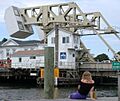List of bridges on the National Register of Historic Places in Connecticut facts for kids
This page lists some of the amazing old bridges and tunnels in Connecticut that are so special, they've been added to the National Register of Historic Places. This means they are important parts of history and architecture in the U.S. and are protected. These structures show how people built things long ago and how they helped connect different parts of the state.
Contents
Connecticut's Historic Bridges and Tunnels
Connecticut is home to many historic bridges and a few tunnels that tell stories of the past. These structures helped people travel, move goods, and connect communities for many years. They are like giant outdoor museums, showing different building styles and engineering ideas from long ago.
Cool Bridge Styles You'll Find
Bridges aren't just about crossing water; they come in many cool designs! Here are some types you'll see among Connecticut's historic bridges:
Arch Bridges
Many old bridges use an arch shape, which is very strong. Imagine a giant rainbow made of stone or concrete!
- The Arrawanna Bridge (built 1918) in Middletown is a concrete arch bridge. It's a great example of how concrete was used to make strong, beautiful bridges.
- The Bulkeley Bridge (built 1908) in Hartford is a huge stone arch bridge. It's a very important landmark in the city.
- The Farmington River Railroad Bridge (built 1867) in Windsor is another impressive stone arch bridge, built for trains.
- Several "Bridge No." structures, like Bridge No. 1603, 1604, and 1605 in East Haddam, are rustic stone arch bridges built in the 1930s. They blend in with nature.
- The Pequabuck Bridge (built 1832, 1833) in Farmington is an old stone arch bridge that has stood for nearly 200 years.
- The River Road Stone Arch Railroad Bridge (built 1887) in Colchester is another example of a strong stone arch built for trains.
- The Stone Bridge (built 1833) in Hartford is a historic stone arch bridge that has been around for a very long time.
Truss Bridges
Truss bridges use a framework of triangles to make them strong and light. They look like giant erector sets!
- The Blackledge River Railroad Bridge (built around 1912) in Colchester is a Warren truss bridge, a common and strong design for railroads.
- The Boardman's Bridge (built 1888) and Lover's Leap Bridge (built 1895), both in New Milford, are lenticular truss bridges. Lenticular means they have a lens shape, which looks really unique!
- The Bull's Bridge (built around 1870) in Kent is a Town lattice truss covered bridge. Covered bridges are special because they have roofs and walls, protecting the wooden parts from weather.
- The Comstock's Bridge (built 1840, 1868) in East Hampton is a Howe truss covered bridge. It's another beautiful example of a covered bridge.
- The Drake Hill Road Bridge (built 1892) in Simsbury is a Parker truss bridge, known for its strong design.
- The Glen Falls Bridge (built 1886) in Plainfield is a lenticular through truss, meaning the traffic goes *through* the truss structure.
- The Main Street Bridge (built 1888) in Stamford and the Melrose Road Bridge (built 1888) in East Windsor are both lenticular pony truss bridges. "Pony" means the truss doesn't go above the roadway.
- The Minortown Road Bridge (built 1890) in Woodbury is another lenticular pony truss.
- The Pine Creek Park Bridge (built 1872, 1890, 1979) in Fairfield is a Pratt pony truss.
- The Red Bridge (built 1891) in Meriden is a lenticular truss bridge, known for its distinctive shape.
- The Sheffield Street Bridge (built 1884) in Waterbury and the Washington Avenue Bridge (built 1881) in Waterbury are also lenticular pony truss bridges.
- The Town Bridge (built 1895) in Canton is a Parker through truss.
- The Turn-of-River Bridge (built 1892, 1893) in Stamford is a lenticular pony truss, now used only for walking.
- The West Cornwall Covered Bridge (built 1864) in West Cornwall is a famous Town lattice truss covered bridge, a true Connecticut icon.
- The Willimantic Footbridge (built 1906) in Willimantic is a steel truss footbridge, meaning it's just for people walking.
Movable Bridges
Some bridges can move to let boats pass!
- The Housatonic River Railroad Bridge (built 1904) between Milford and Stratford is a Scherzer Rolling Lift Bascule bridge. A bascule bridge is like a seesaw that lifts up.
- The Mystic Bridge Historic District (built 1922) in Mystic features a Strauss Heel Trunnion Bascule bridge, a very cool design that lifts up to let tall ships pass through.
- The Norwalk River Railroad Bridge (built 1896) in South Norwalk is a Rim Bearing, Swing bridge. This type of bridge swings open like a gate.
- The Pequonnock River Railroad Bridge (built 1902) in Bridgeport is a Through Girder Bascule bridge.
- The Saugatuck River Bridge (built 1884) in Westport is a Pin-connected swing bridge.
- The Saugatuck River Railroad Bridge (built 1905) in Westport is a Deck Girder, Bascule bridge.
- The Washington Bridge (built 1921) between Milford and Stratford is an open-spandrel concrete arch bascule bridge, combining two cool features!
Other Notable Structures
- The Lyman Viaduct (built 1873) in Colchester is a buried wrought iron railroad trestle. A viaduct is like a very long bridge that crosses a valley or many obstacles.
- The Merritt Parkway Bridges (built 1930s) are a collection of 66 bridges along the Merritt Parkway in Fairfield County. They are famous for their beautiful and unique designs, including Art Deco and Art Moderne styles, making them look like works of art!
- The Rapallo Viaduct (built 1873) in East Hampton is another filled-over wrought iron railroad viaduct.
These historic bridges and tunnels are not just old structures; they are important parts of Connecticut's story, showing how people built amazing things that still stand strong today.
Images for kids





















































